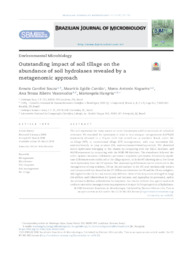Outstanding impact of soil tillage on the abundance of soil hydrolases revealed by a metagenomic approach.
Outstanding impact of soil tillage on the abundance of soil hydrolases revealed by a metagenomic approach.
Author(s): SOUZA, R. C.; CANTAO, M. E.; NOGUEIRA, M. A.; VASCONCELOS, A. T. R.; HUNGRIA, M.
Summary: Abstract: The soil represents the main source of novel biocatalysts and biomolecules of industrial relevance. We searched for hydrolases in silico in four shotgun metagenomes (4,079,223 sequences) obtained in a 13-year field trial carried out in southern Brazil, under the no-tillage (NT), or conventional tillage (CT) managements, with crop succession (CS, soybean/wheat), or crop rotation (CR, soybean/maize/wheat/lupine/oat). We identified 42,631 hydrolases belonging to five classes by comparing with the KEGG database, and 44,928 sequences by comparing with the NCBI-NR database. The abundance followed the order: lipases > laccases > cellulases > proteases > amylases > pectinases. Statistically significant differences were attributed to the tillage system, with the NT showing about five times more hydrolases than the CT system. The outstanding differences can be attributed to the management of crop residues, left on the soil surface in the NT, and mechanically broken and incorporated into the soil in the CT. Differences between the CS and the CR were slighter, 10% higher for the CS, but not statistically different. Most of the sequences belonged to fungi (Verticillium, and Colletotrichum for lipases and laccases, and Aspergillus for proteases), and to the archaea Sulfolobus acidocaldarius for amylases. Our results indicate that agricultural soils under conservative managements may represent a hotspotfor bioprospection of hydrolases.
Publication year: 2018
Types of publication: Journal article
Unit: Embrapa Swine & Poultry
Observation
Some of Embrapa's publications are published as ePub files. To read them, use or download one of the following free software options to your computer or mobile device. Android: Google Play Books; IOS: iBooks; Windows and Linux: Calibre.
Access other publications
Access the Agricultural Research Database (BDPA) to consult Embrapa's full library collection and records.
Visit Embrapa Bookstore to purchase books and other publications sold by Embrapa.

